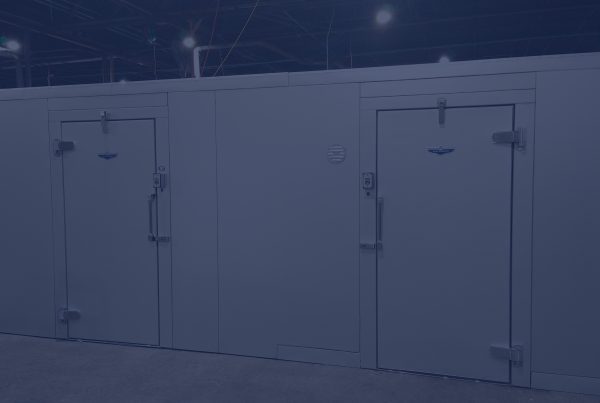When troubleshooting walk-in freezers, technicians often find a frozen evaporator coil. Although there are several possible causes, one common cause involves the defrost system. For some reason, the system is not properly defrosting the evaporator’s coil on a regular basis. In order to effectively troubleshoot this problem, a technician must understand the design and operation of the defrost systems typically used.
One popular method of defrosting walk-in freezers is the electric defrost system. This is comprised of several components, including a defrost timer, resistive heater(s), defrost termination switch, fan cycling control, and drain line heater. An electric resistance heater is placed on the outer surface of the evaporator’s coils. The energized heater supplies enough heat to completely defrost the coils.
The resistive heaters used on a typical electric defrost system are sized to provide sufficient heat to effectively defrost the coil’s surface. Their capacity is normally rated in watts per foot. They are shaped to fit snugly onto the coil surface, creating efficient heat transfer during defrosts.
Most heaters are manufactured for a specific coil, and when replacing these heaters it is best to obtain the OEM replacement. Universal defrost heaters are available, but matching their wattage and shape may be difficult.
A defrost timer controls the entire defrost operation. It initiates the defrost cycle, controls the operation of the compressor and defrost heaters, and is part of the defrost termination. Defrost timers can be adjusted to initiate defrost from just once a day to several times a day.
The actual number of defrosts per day depends upon the location of the walk-in. Walk-in freezers are usually designed to defrost once or twice a day. The more humid and warm a location, the more defrosts will be needed. If a system needs to be defrosted more frequently, add only one additional defrost period at a time and monitor the results. Adding too many defrost periods will not be beneficial to the system or the customer.
In a common wiring diagram for a time-initiated, temperature-terminated electric defrost system the time motor (TM) is energized continuously. Normally closed contacts 2-4 of the defrost timer are wired in series with the compressor and the evaporator fan motor (EFM). Normally open contacts 1-3 are wired in series with the electric defrost heaters and the timer release solenoid (TRS).
The timer motor controls the operation of contacts 2-4 and 1-3. They work opposite each other. When contacts 2-4 are closed, 1-3 are opened. When contacts 2-4 are opened, 1-3 are closed. When the timer motor initiates a defrost, contacts 2-4 will open and 1-3 will close. This stops the compressor and the evaporator fan motor, and energizes the defrost heaters.
DEFROST CYCLE TERMINATION
A defrost cycle can be terminated based on temperature, pressure, or time. These three methods are commonly referred to as time-temperature (defrost cycle initiated by time, terminated by a temperature switch), time-pressure (defrost cycle initiated by time, terminated by a pressure switch), and time-time (defrost cycle initiated by time, terminated by the defrost timer). Most defrost timers will also have a fail-safe time which can be set to terminate the defrost based on time.
On systems being terminated by a pressure or temperature switch, if the termination switch fails, the defrost will be terminated by time. The fail-safe time should be set long enough to allow the system to terminate by the temperature or pressure switch, and short enough to prevent the system from over defrosting or creating a hazardous condition by having the heaters energized all the time. Usually the fail-safe time is 35-45 minutes.
Terminating a defrost cycle by temperature is the most popular method. A temperature control is used as the defrost termination switch. It is installed on the evaporator at a location where the design engineers feel that frost will leave the coil last. At a specified temperature, the defrost termination switch closes and energizes the TRS, switching the system back into the refrigerating mode. (The TRS is an electrical solenoid located in the defrost timer.) When the TRS is energized, it mechanically switches the timer contacts: 2-4 will close and 1-3 will open.
The temperature at which the defrost termination switch closes will vary from design to design. Check with the manufacturer to determine the temperature setting. Some defrost termination switches will have their settings stamped onto the body of the device. One typical temperature cut-in used on many systems is 60°F.
The defrost cycle can also be terminated by a pressure switch, where a pressure control is used as the defrost termination switch. It is connected to sense the pressure of refrigerant in the evaporator. When it senses a pressure that will ensure all the ice is removed from the evaporator, it will close and terminate defrost. Many times the pressure control and defrost timer are combined into one unit. The pressure at which the pressure switch closes will depend on the type of refrigerant used in the system. Check with the manufacturer.
The defrost timer can also be used to terminate defrost by time, although this method isn’t very popular. The time required to defrost an evaporator varies depending on how much frost has developed on the coil. The ambient humidity level and usage of the walk-in affect how much frost develops on the coil. If the walk-in is in a very humid location with heavy usage, a heavy accumulation of frost will develop on the coil. If the walk-in is installed in a location where the humidity level is low and has very little usage, the frost will be less for the same amount of time.
Article originally published at ACHR NEWS by Joe Marchese, owner of Coldtronics of Pittsburgh. He can be reached at joe[at]coldtronics.com.





Please change the picture shownn on the article on “Troubleshooting Defrost Problems”. The picture shows an air conditioning evaporator, but article is based on a walk in refrigeration system. If you need a picture let me know and I can supply you with one.
We recently installed three Endocubes into our walkin coolers and one in the walk0in freezer. the coolers are 12 x 8 and we were always getting a build up even though our temperatures seemed consistent.
The endocube is a small box which contains a food simulant which you place over the existing air temperature probe. Now what happens is you are controlling the equipment based on food temperatures and not air. So when you doors continuously being open as we have, the compressor only kicks on when the probe is within 1 degree of the set point of the food not the air.
This means less starts and stops, and even though you have longer run times, you also get longer rest times. We went from a 18run time with a defrost every 36 hours and then went to 78 hours and now we have everything balanced, we have now reduced to one defrost every 168 hours which is incredible.
So we have saved a lot of money from not having defrosts, and also the reduction in cycling and KWH is also a massive bonus. Google Endocubeinfo or Refrigeratorsaver worth a visit.
why is my cooler temperature dropping so low and freezes all the drinks?
this is a good article to read it gives u good knowledge on hhow there are different defrost system and how they work and the amount of cycles needed for different areas.